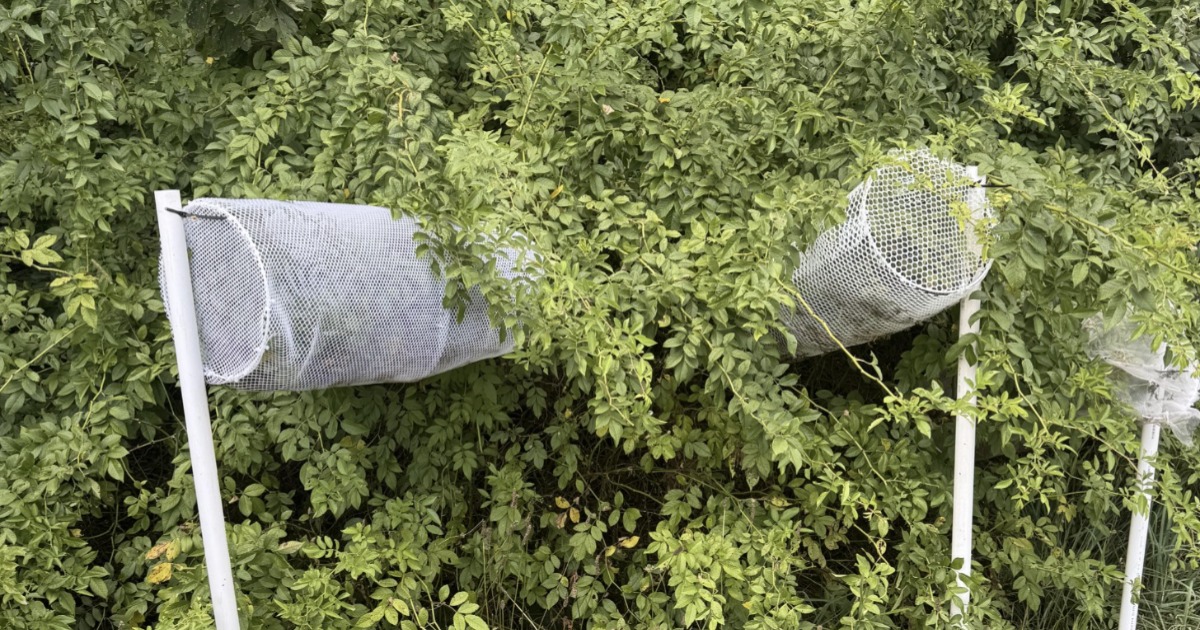Why Is This Even Here?

Source: Reddit
While you may be walking around a nature preserve in northeastern Ohio, there is a good chance that you may see something a bit strange: mesh tubes mounted on white poles, hovering over thick rose bushes. These tubes may resemble junk, suggest that someone created a piece of public art the city commission didn’t approve at their last meeting, or reflect a failed attempt to catch bugs. However, scientists actually developed them as the most recent science-based method for rose rosette disease monitoring. This is a factor in controlling an aggressively invasive species.
The Problem: Multiflora Rose
The dense vegetation under the tubes is often multiflora rose (Rosa multiflora), a non-native shrub from Asia. It was introduced in the 1800s for use in fencing and as an erosion control plant. Multiflora rose spread quickly. It now dominates native plants by replacing them with its dense thickets underlying forests, fields, and roads.
Getting rid of multiflora rose is difficult. Once removed, it can grow back quickly. It is resistant to many herbicides. If you were able to remove the stem, any root pieces in the ground can also sprout. Regular rose rosette disease monitoring is crucial in managing this invasive species effectively.
An Unlikely Method: Rose Rosette Disease
Rose rosette disease (RRD) is a virus that infects rose plants, causing red growth that distorts normal leaf and stem development. It encourages excessive thorniness and can kill the entire plant. The virus is often transmitted by a tiny microscopic mite, Phyllocoptes fructiphilus. This mite moves between plants by air movement or human or animal contact.
While RRD often kills ornamental rose plantings, it is especially deadly to multiflora rose. As a result, RRD and its relationship to multiflora rose has made rose rosette disease a natural ally. It helps save controlling the spread of the invasive plant. Therefore, rose rosette disease monitoring is key in this ecological approach.
Researchers and land managers are monitoring RRD to understand how the disease is spreading through landscapes. Rose rosette disease monitoring involves investigating how it may or may not be affecting the populations of multiflora rose that they can remediate.

What the Mesh Tubes Do
Researchers place mesh tubes—often called sleeve traps—directly over multiflora rose bushes to trap mites. They use a sleeve trap to gather mites to measure their abundance.
How they work:
- The fine mesh allows air to move through but traps mites, ultimately trapping them above the bush.
- Some have sticky cards or sticky surfaces that also collect the mites or provide a sticky surface to catch the mites.
- The tubes are suspended on poles above the foliage to provide stable placement and allow airflow.
Researchers used these traps to:
- Verification of where the mites were present.
- Identification of patterns related to virus transmission between rose bushes.
- Monitoring of disease spread and impacts on the invasive rose populations, over time, and space.
These traps are passive devices that capture data in dense vegetation where surveying could be difficult or impossible.
Similarity to Spotted Lanternfly Traps
In places like the Bronx Zoo, staff use traps that look similar to the mesh tubes to capture spotted lanternflies. This is also an invasive species. These traps are used to catch large, mobile insects. Workers place them around trees or along paths to capture movement from anchor infestations.
Although the two types of traps are both mesh and on poles, they very different in purpose and placement:
- Rose rosette traps sit over rose bushes to catch mites; and
- Spotted lanternfly traps are designed for larger insects and often include attractants and/or sticky surfaces to confirm presence and abundance.
While it is easy to confuse the two, they do fulfill very different roles when it comes to the purpose of conservation.
Managing Invasives Without Chemicals
Rose rosette disease is a biological control that does not require the use of herbicides or mechanical removal of the rose bushes. By tracking the spread of rose rosette disease, land managers will be able to predict areas where multiflora rose populations are declining. This prediction allows them to direct action in areas that have not required management for regrowth.
This is simply another method in a larger ecological strategy. Martineck aims to restore ecosystems that invasive plants have disturbed.